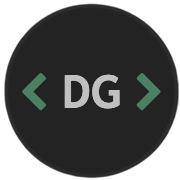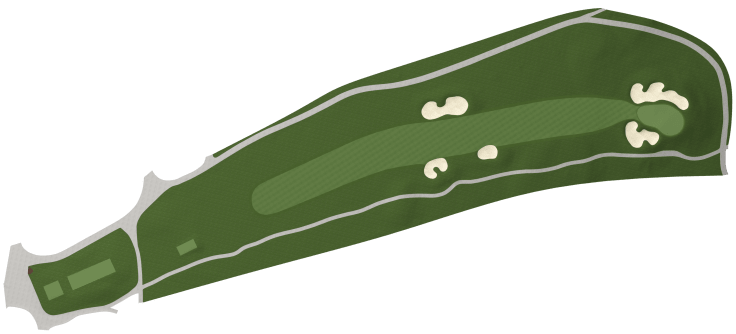
 Hole Mappings — Torrey Pines (South)
Hole Mappings — Torrey Pines (South)
UPDATED —
GENERAL NOTES
The data used here is from the 2017-2021 Farmers Insurance Opens.
We divide each hole into grids made up of circles with 5-yard diameters.
For par 4s and 5s we display two grids: one that spans the typical landing area of most drives, and a second that surrounds the green.
The par 3s only have the green-surround grid.
Our goal is to estimate and visualize the number of strokes it takes to hole out from each of these circles.
There are several views available in the righthand dropdown.
"Shot count" displays the number of shots in each circle;
"Avg strokes to hole out" displays the average number of strokes a player took to hole out from that circle;
"Smoothed strokes to hole out" smooths the raw data to make it more interpretable (more info in next note);
the final two views allow you to filter the smoothed data to only include (or exclude) fairway shots. Note that
"fairway" includes the intermediate rough.
The smoothed value for each circle is equal to a weighted average of "nearby" shots, where the weights are determined by the distance between the circle of interest and each shot, with closer shots receiving more weight.
Only shots that are hit from the same lie type (fairway, rough, bunker) receive non-zero weight.
The optimal distance-weight function is chosen to maximize predictive power.
The South Course at Torrey Pines underwent changes in between the 2019 and 2020 seasons.
In places where changes occurred — i.e. nearly all landing areas for drives, and about 1/3 of the green complexes —
we only use the 2020-2021 data to define the lie type (fairway, rough, bunker) of each circle on the grid below.
Consequently, there can be slight mismatches between the raw data and the smoothed data if, for example, a bunker is now positioned where a section of fairway used to be.
However, as said above, the smoothed value of that circle will only use nearby bunker shots, even though raw data in that circle will contain some shots from the fairway pre-2020.
It is very important to understand the colour scales we use!
First, as a general principle, orange means easier and blue means harder.
For the "average strokes" and "smoothed" views, we set the neutral value to be 3.0 on par 4s and 4.0 on par 5s.
Importantly, neutral circles are transparent and as such can easily be missed.
For the fairway-only or non-fairway views, the neutral value is set to the average value of the circles being displayed.
For example, in a non-fairway view, an orange circle will be interpreted as a location that plays easier than the average non-fairway location on that hole.
There are some other important details that you hopefully will come across in the notes accompanying each hole. Now, start digging!
Full Hole View
HOLE 1
PAR 4 — 455 YDS
TEE SHOT DISTRIBUTION
FAIRWAY
59.2%
LEFT ROUGH
14.4%
RIGHT ROUGH
12.1%
BUNKER (LEFT OR RIGHT)
14.2%
PENALTY
0.0%
AVERAGE SCORE FOR TEE SHOTS...
HITTING FAIRWAY
3.97
MISSING FAIRWAY
4.33
IN LEFT FAIRWAY
3.98
IN RIGHT FAIRWAY
3.95
MISSING LEFT
4.34
MISSING RIGHT
4.33
BIN SUMMARY
LOCATION
SHOT COUNT
—
AVERAGE STROKES TO HOLE OUT
—
SMOOTHED STROKES TO HOLE OUT
—

HOLE 1 NOTES
The short-right fairway bunker collects a lot of balls and penalizes players nearly half a shot relative to hitting the fairway.
In addition to having space for extra rollout, the left side of this hole is playable and offers a nice angle into the green (if you care about such things).
For longer hitters, the right miss is not much of an issue as long as they cover the first bunker on the right; anything beyond that seems to be favourable relative to a left miss of similar distance.. So aim right and bomb away Wilco.
The front-right greenside bunker is a popular spot but also relatively benign, averaging 2.5 strokes to hole out. The bad miss here is short right of the bunker, or long left (shocker).
Tipping out at 400 yards, some guys will be able to get close to this green.
Most players, however, will take a more prudent approach and bunt their drives 280 up the fairway towards the left bunker, leaving about 110 yards to the green.
Interestingly, the approach shot from under 80 yards (specifically in the left portion of the fairway) plays harder than the approach further back in the fairway.
Since we aren't adjusting for skill or pin location, you might think there could be some selection bias here (e.g. the hole is playing downwind one day which allows the players to hit it inside 70 yards, while also making the approach harder).
However, we dug into this data and it's pretty spread out over many rounds and pin locations, and there was no systematic pattern related to skill.
A lot of balls seem to end up long of this green.
This makes sense given that players will be chipping back up the hill from there, and the bunkers guarding the front of this green are no picnic (~2.8 strokes to hole out, compared to the typical 2.5).
Again, in all of this, remember we aren't controlling for pin location; most of the long misses were probably playing to back pins, making the chip easier.
Nothing too interesting to say here, but let’s clarify how you should think about hazards and out-of-bounds in these visualizations.
We aren't including penalties in the strokes to hole out; therefore, the interpretation is the number of strokes to hole out if you were to drop a ball and play it from that spot.
With a cliff hugging the left side, it's no surprise that the right bunker is a popular spot, especially for those of us who fear the dreaded left miss...
The roughly 55% of players who find the fairway will be rewarded with a 0.3 stroke advantage over those who choose to take their medicine and bail right.
It's worth noting that, in general, the penalty for being in the rough at South Course — between 0.3 - 0.35 strokes — is slightly higher than the typical PGA Tour penalty (~0.25 strokes).
Interestingly, despite being close to hole, the second bunker on the right appears to be worse than the first.
Angles, angles, angles.
If you can hit it far enough, the right rough is pretty good here (use the "exclude fairway" view to see this more clearly).
From 170 yards, the (far) right rough plays 0.3 shots easier than shots from the narrow strip of left rough.
The fairway also displays a slight advantage to approaches up the right side.
Still waiting for confirmation as to whether this is a real hole, as nobody we've spoken to can recall it existing in previous events played here.
Usually plays as a 5-par, but will be playing as a par 4 this week.
The left miss off the tee is playable, it just makes the hole play longer.
Given this, it's surprising that this hole has the 3rd highest percentage of tee shots in the right rough.
Approach shots that end up short and right of the green in the rough will make for a tough up-and-down.
The left rough is easier to score from, providing a better angle into the green.
But, going up the left also requires a much longer tee shot to reach the equivalent distance to the pin for a similar-length drive down the right.
For example, a 310-yard drive might yield a 175-yard approach from the left rough (with a smoothed average of 3.3 strokes), while a 310-yard drive into the right rough might end up 135 yards from the green (with a smoothed average of 3.4 strokes).
This is an important point that is sometimes forgotten when thinking about angles: often finding an approach to the green with a better angle requires playing a longer hole (and as we know, all else equal, longer means more difficult).
The second bunker on the left appears to be no fun.
One of the few holes at Torrey Pines where long appears to be the worse miss.
Little known fact, the 9th is nicknamed "Skinny".
If you are going to miss here, bailing right is the sensible option; the first bunker on the left is more penal than the one on the right, despite being slightly closer to the green.
As we've already seen on several holes, when there is a better side to miss it off the tee, the pros gravitate towards that side.
No different here, with the right bunker and rough gobbling a lot of balls.
Using the "exclude fairway" setting, we see a slight advantage to favour the left here.
However, it's important to be able to carry the left bunker: hitting it in there seems to be the worst spot from the 155-160 distance, while carrying it is the best non-fairway location to approach the green from. Enter Bryson.
Up by the green, the area near the left cart path may not seem ideal at first glance,
but remember that balls hit to this spot have shown a tendency to plug (sometimes even on the second bounce)
giving players a free drop and a great chance to save par.
Right is typically the better miss here (although, of course, it will depend on where exactly the pin is).
The bad news here is that no matter where you hit your tee shot — on the grid we consider — your expected score will still be above par.
The 12th has the largest difference in scoring average between drives that find the fairway and those that don't: 0.45 strokes.
The right side is especially penal (easier to see this using the "exclude fairway" view).
The difference between being in the right fairway and right bunker gets as high as 0.6 strokes in places.
In line with popular opinion, short right of this green is jail.
#angles. Moving further into the right rough sees the smoothed strokes to hole out decline.
Remember that neutral circles (those with a value of 3.0 on par 4s) are transparent in the two main views.
If you toggle to the "avg strokes to hole out" view, you'll notice the data is not that sparse on the right, so these numbers are somewhat trustworthy.
Taking the #angles narrative to the limit, the small area past the second bunker is the best non-fairway location to hit from, perhaps allowing access to back right pins.
Trees down the left side of this hole make it the worse miss. Looks like a 0.2-0.3 shot difference when comparing the Big Left miss to the the Big Right.
Just barely edges out 11 as the par 3 with the largest difference in scoring average between those that hit the green and those that don't (~0.6 strokes).
2.7% penalty rate off the tee, but this has likely been higher since 2020 when they shifted the fairway left.
Interestingly, going up the right side is better (compared to the narrow strip of left rough) if you are within 150 yards of the green, but worse if you are outside of that distance.
Of course, there is a hazard down the left to gobble up Phil's block slice.
Players bail right here more than any other hole on the course.
Bombing one down the right seems okay if you advance it far enough.
The left bunkers are also a somewhat surprising bad miss.
The data is sparse, but if a player somehow finds themselves in the rough left of the left greenside bunker they can expect to get down in 3.